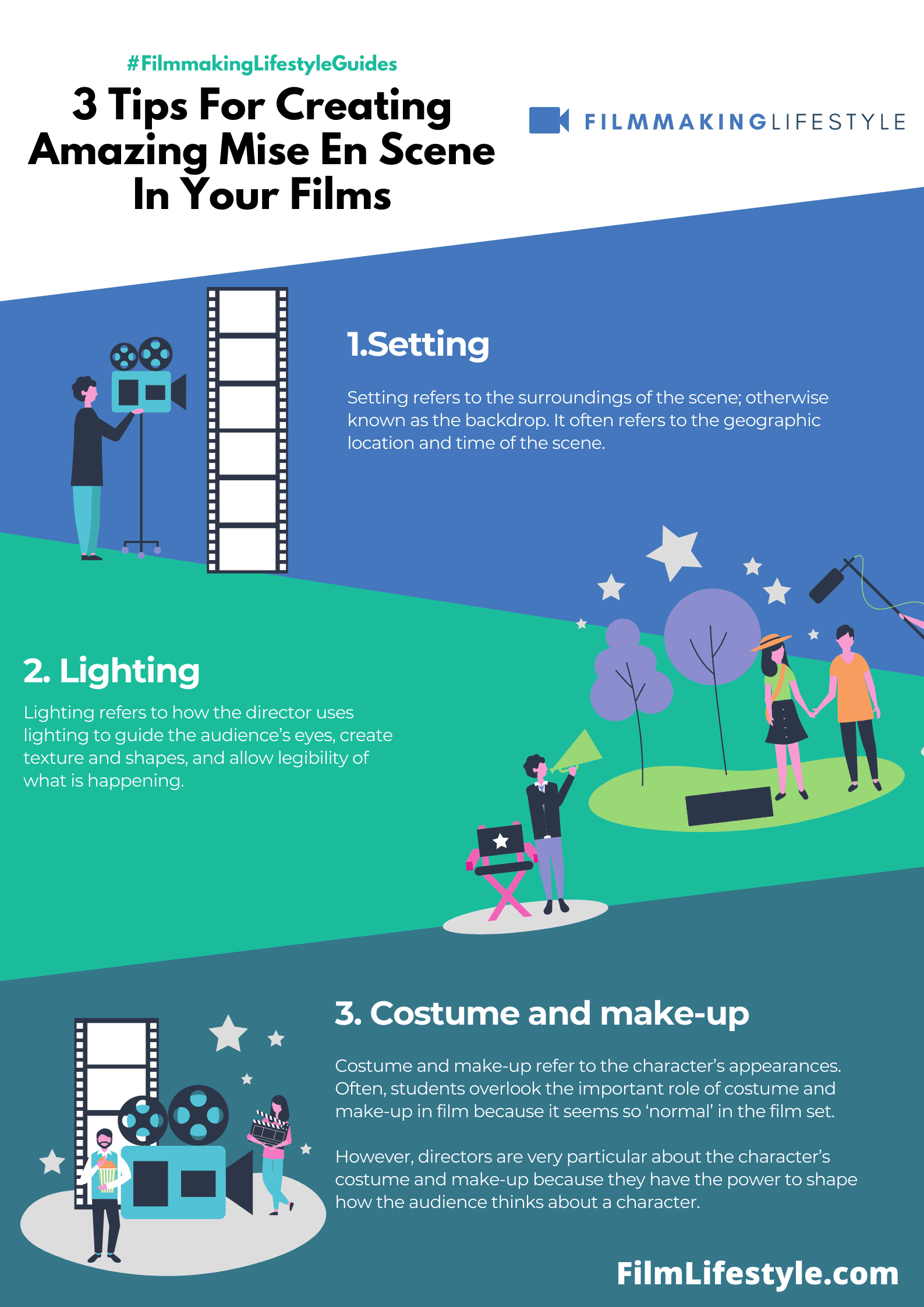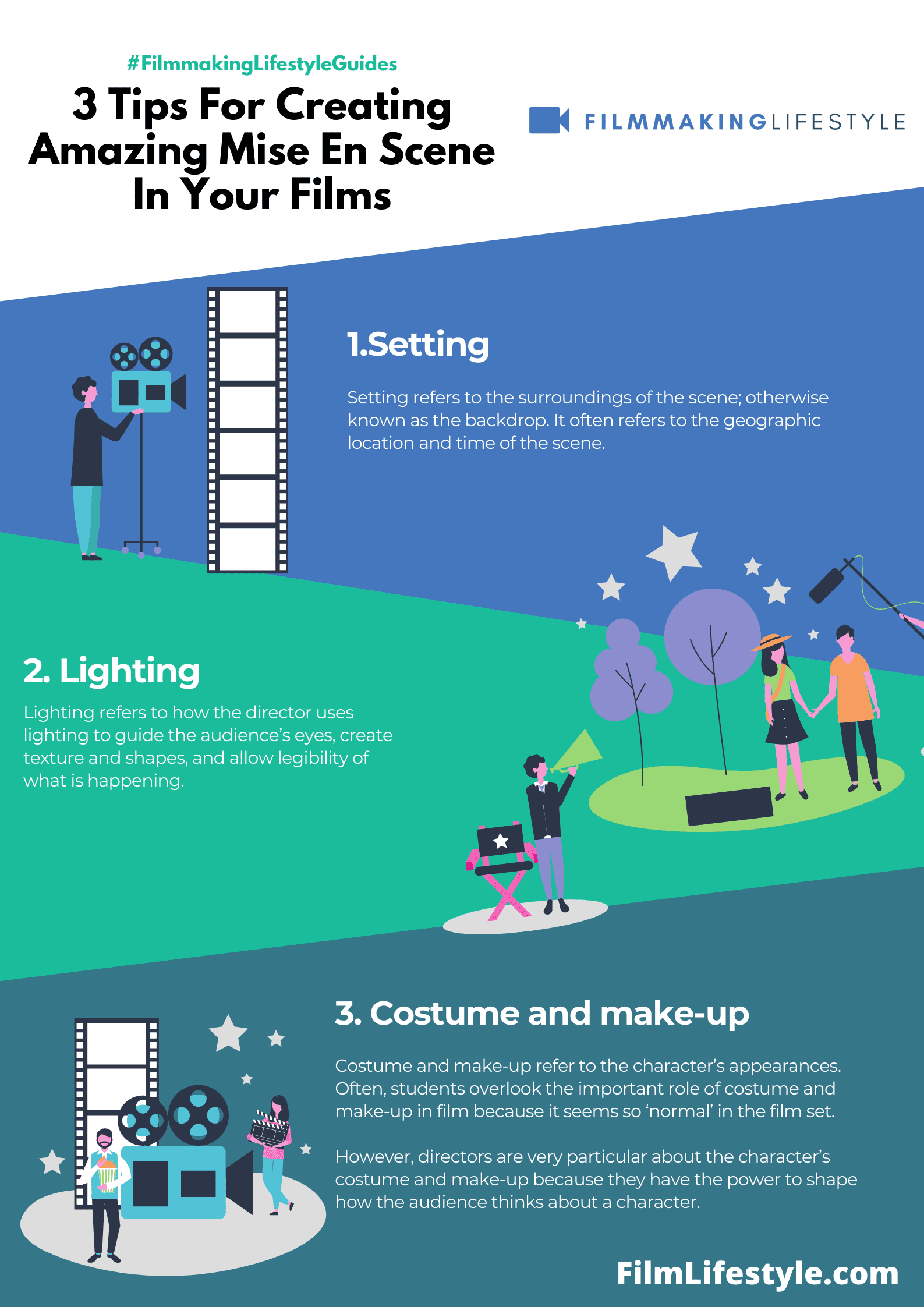Mise en scene is a term used in film production to describe the arrangement of elements within a frame.
The term was coined by Alexandre Dumas, père from the French for “putting on stage” or “setting up.” It refers to the arrangement of scenery and props on stage.
MISE EN SCENE DEFINITION
What Is Mise En Scene?
Mise en scene is a term that has been translated to “putting on the stage.” It can be used in both theater and film.
In film, it refers to the placement of objects (or lack thereof), actors, and other elements within the frame.
The purpose of this positioning or staging is to make meaning for an audience by suggesting what might be happening outside of what we are seeing in the camera’s viewfinder.
Mise En Scene Definition
Mise en scene can be considered as one of the four basic elements in art, along with color, line, and texture. This includes set design, costume design, lighting, sound effects, and music.
The goal of mise-en-scene is to create an illusion for the audience so they can suspend their disbelief and get lost in the story being told by those on stage.
The technique has been used by directors since 1913 with groundbreaking films like Birth Of A Nation directed D.W Griffiths or Citizen Kane directed by Orson Welles as it helped to create a realistic setting for these films about America’s history at that time.
Mise En Scene Elements
Mise en scene is the term used to describe what a director uses to create an environment in the film that can include anything from props, costumes, set design, and lighting.
Mise en scene elements are important because they help build mood and atmosphere for the audience.
The setting can be as simple as an office or as intricate as a rainforest. Mise-en-scenes are a crucial aspect of filmmaking because they help viewers understand what kind of world they’re entering when watching your movie, TV show, or play.
Mise En Scene Acting
It’s an actor’s job to interpret what these meanings are and convey them to the audience through their body language and facial expressions.
Mise en scene actors are able to manipulate an audience’s perception through what they say and do, rather than relying on costumes or scenery.
Alfred Hitchcock was well known for his use of mise-en-scene to create suspenseful moments.
A mise en scene actor will use all these elements to create an emotion or feeling within their audience through their performance, which can change depending on what they’re wearing, what they’re using as props, etc.
Mise en scène includes many aspects of filmmaking such as camera placement, composition, lighting, and foreground-background relationships.
Mise en scène can also include more stylistic decisions such as color and direction of movement or focus.
First Known Use Of Mise-en-scène
One of the first known uses of this term was by Constantin Stanislavsky, who used it to describe his theory of theatrical production.
He believed that the setting determines how an actor should behave in order to portray their character.
It’s often used in film, but it has been around since at least the late 1700s when French novelist Denis Diderot wrote about it in his novel “Jacques le Fataliste.”
In this novel, he describes a theatrical performance as one where every element of the production was carefully planned out to create an emotional response on stage, he described it as “a scene arranged for theatrical representation”.
Another example of mise-en-scène being used in cinema can be seen in the 1915 silent movie A Scandal In Bohemia by Maurice Elvey, which also happens to be the first Sherlock Holmes adaptation ever made.
Mise En Scene And Cinematography
Cinematography is a word that might be used to describe the way a movie was shot, or how it looks. It can also refer to the arrangement of shots and camera angles in a film.
Mise en scene refers to all aspects of the visual setting in which actors perform their parts.
Both words are important for understanding movies and films as they give you insights into what went on behind the scenes when making them.
The first thing a director should consider when setting up the mise en scene is whether they want to use natural or artificial light. Natural light is generally softer and more flattering than artificial light, but it can be difficult to control.
Artificial lights are easier to manage because they have adjustable brightness levels and different settings like strobe lights that help create interesting effects in low-light scenes that create meaning through spatial arrangements in films.

Mise En Scene And Blocking
Mise en scene and blocking are two elements of the filmmaking process that can make or break a movie. A director will often spend weeks, even months planning out every single detail of their film before they even start shooting.
They’ll map out where everything is in the scene, what everyone’s movements are going to be like, and how each shot should go from one to another.
Mise en scene is the term given to all of the elements of a film, play, or other performance that contribute to the overall staging and composition.
Matt Crawford
Related posts
4 Comments
Leave a Reply Cancel reply
This site uses Akismet to reduce spam. Learn how your comment data is processed.






I’ve been wanting to learn more about mise en scene for a while now. This post has given me a lot to think about.
Thanks.
Great article! I’m really interesting in learning more about Mise En Scene and how it applies to filmmaking. The examples you provided were especially helpful in illustrating the different elements that can be used to create a visually appealing scene. I can’t wait to try out some of these techniques in my own filmmaking projects. Thanks for sharing!
Thank you